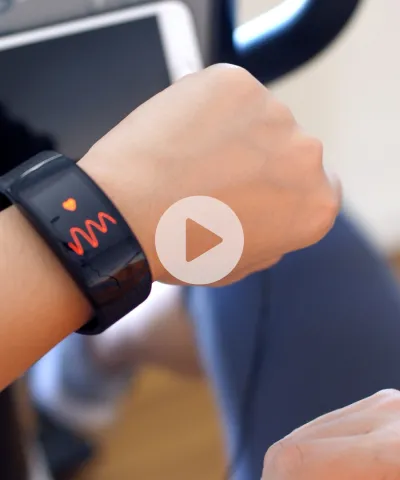The wearables market is dynamic and constantly evolving, with new and established players competing for relevance. We explore growth strategies and discuss how connecting the dots between wearables and healthcare can unlock new opportunities.
Today’s consumers wear their hearts on their sleeves. Or rather, around their wrists. With over 200 million users of smartwatches worldwide, consumers everywhere are gaining real-time data on their heart rate and other health-related aspects including sleep patterns and activity. The convenience and accessibility of health wearables, combined with their ability to provide personalized data, make them a popular choice for those interested in improving their health and wellness.
Consumers are not only focused on being healthier – they also want to understand the hows and whys. Wearables are able to provide valuable information in increasingly small form factors, answering questions like “how can I sleep better?” or “why do I feel so stressed?” Some wearable medical devices even track vital signs such as blood pressure, oxygen levels, and glucose levels.
The future is wearable
It’s an exciting time to be in the wearables space. In the US, the wearables market size amounted to 17.2 billion dollars in 2022 and is forecasted to reach a value of over 23 billion dollars by 2026. The success comes at a time of growing attention toward the prevalence of obesity and greater awareness around the importance of physical fitness. However, there are many established players in the wearables market and establishing a competitive edge can be challenging.
At Simon-Kucher, we believe in better health. We see opportunity for the healthcare industry to deliver even more value by focusing on maintaining and improving health, going beyond just treating diseases. Here, our longstanding expertise in global healthcare, digital services, and the consumer healthcare sector puts us in an ideal position to advise companies looking to achieve better growth through wearable health technology.
Whether you’re a newcomer looking to break into the space or an established player aiming for long-term, sustainable growth, we are here to help you navigate this dynamic landscape.
How to break into the wearables space
Nailing the basics – you can’t go anywhere without a good foundation.
Define product-market fit: Step one is to segment consumers to define the product-market fit. By dividing the market into smaller groups with similar needs, characteristics, or behaviors, you can identify white spaces with unique requirements and build a relevant value proposition. One-size-fits-none. Go too broad, and you will miss everyone.
At Simon-Kucher, we routinely work with young and established organizations to figure out the best market opportunities for them. We bring a customer lens to developing new product offers and services, accurately modeling the financial impacts and increasing the chances of success for new launches.
Develop with your target group in mind: Step two is to develop your product for the right target. What do you want to offer and how does your portfolio look like? Identify the must-haves, should-haves, and could-haves for a target segment, categorizing product features and requirements based on their importance and priority. Must-haves are non-negotiable and are essential to satisfy the target segment’s basic needs (e.g., accurate tracking). Should-haves are prioritized after the must-haves to add value and enhance the user experience (e.g., wireless connectivity.) and provide competitive differentiation. Could-haves are typically low priority and may be included after all must-haves and should-haves have been addressed (e.g., voice control).
At Simon-Kucher, we understand the importance of the customer. We will work with you to develop strong value propositions and services based on a deep understanding of value delivery and willingness to pay. Our work ranges from value proposition and portfolio design to product positioning. All rigorously researched and tested.
- Monetize the innovation: Step three is to determine how to monetize and drive revenue growth. This is essential for the long-term success and sustainability of your wearable product. If you are not generating revenue, you won’t be able to invest in future growth. We can help your organization determine how to capture the full value of a product and define the value drivers for sustained customer lifetime relationships.
Case example: WHOOP
WHOOP is a digital health and fitness coach designed to help users optimize their performance, recovery, and sleep. It consists of a wearable device and a mobile app that work together to track and analyze various health metrics, including heart rate variability (HRV), resting heart rate, and sleep stages.
At launch, WHOOP focused on a very specific customer segment: elite and competitive athletes, targeting MLB, PGA, NFL, and NBA professionals at launch. What differentiated WHOOP from the competition was its advanced algorithm for activity detection, personalized insights, and form factor. WHOOP’s hyper-personalized and data-focused solutions were very valuable and specific to the target segment. Only after success with this segment did WHOOP expand to the “aspirational athlete,” with early marketing toward cross fitters and cyclists.
WHOOP emphasizes data privacy and its flawless digital experience as selling points to differentiate the wearable from other fitness trackers. It has a flexible, durable, and comfortable form factor that is non-invasive and easy to use while it collects 1,000 times the amount of data than more general competitor solutions such as a Fitbit or Apple Watch. WHOOP is also predicated on what isn’t included, such as a screen, so that features like battery life can excel.
WHOOP offers “free” hardware. The real recurring value they provide (and therefore revenue driver) is the dynamic data collection and insights. After the initial product took off, WHOOP expanded into supporting products such as attire, catered toward the needs of specific athlete segments.
How established wearables players can continue to grow and sustain the customer base
The wearables market is highly competitive, dynamic, and constantly evolving. A high demand for wearable devices, as well as ongoing advancements in technology means even established players must continually innovate and differentiate from competitors to remain relevant and maintain their position. Expansion avenues that established wearables players can explore include enhancing product features, introducing new and innovative products to the portfolio, personalizing the user experience, and expanding into new markets.
It’s also crucial to have a monetization model that works. The most traditional model for wearables is to generate revenue by selling the device itself (hardware sales) without any long-term commitment required from the consumer. However, we are starting to see more innovative pricing in the wearables space. Recurring revenue models like subscriptions provide a more reliable and consistent revenue stream and are often connected to premium features such as advanced analytics, personalized coaching, and exclusive content.
Case example: Garmin
Garmin offers a wide range of price points for products within each sports line, with each product targeting athletes at different levels (i.e., beginner, advanced athlete, etc.). For instance, within the golf sports line, there is “S42” at $299.99 for casual golfers, “MARQ” at $2,300 for seasoned golfers, and many options in between.
Garmin established itself by creating reliable GPS systems that could be used in aviation, navigation, communication, etc. Building upon the strong foundation of its well-developed GPS systems, Garmin entered the sports wearables space by utilizing this GPS tracking technology for its watches for runners, golfers, swimmers, and many other athletes.
As the leading pricing experts, we at Simon-Kucher can help you pressure test your existing pricing and potential new monetization paths for each channel you sell through. We also regularly work with established players in the market to help them identify white spaces and growth opportunities.
Wearables partnerships that generate broader impact
When people hear wearables, they think of features like counting steps and calories. However, wearables hold greater potential than just leaving consumers to their own devices. There’s huge value in making healthcare more personalized, efficient, and effective. When healthcare systems help populations stay healthy and treat conditions or diseases as early as possible, it leads to better outcomes for everyone: for providers, for patients, and for society.
We expect to see a wider variety of wearable applications with increased relevance in healthcare, including diagnostic and therapeutic devices. Since all of a wearable’s data is collected, tracked, and analyzed through AI in one place, early detection, prevention and diagnosis is possible, especially when paired with the growing popularity of telehealth. But perhaps the most exciting development is the increasing openness among healthcare payers.
One way this openness is taking shape is through partnerships, with consumer healthcare (CHC) companies and other healthcare stakeholders, such as payers, joining forces to pursue a variety of aims:
- Incentivize patients to use wearable devices to monitor their health.
Some insurance companies offer discounts on premiums or other incentives to customers who use wearable devices to track their fitness or other health-related data. - Collect health data that can be used to improve patient outcomes.
Healthcare providers may use wearable devices to monitor patients remotely, which can help them detect potential health issues early and intervene before they become more serious. - Use data collected from wearables to improve healthcare analytics and population health management.
Wearables can be used to identify patterns and trends in health behavior. This information can be used to design more effective wellness programs and disease prevention strategies, reveal unmet needs across patient populations, and inform clinical research and decision-making.
Case example: Fitbit
Fitbit has established partnerships with various healthcare providers and employers to integrate their wearable devices into wellness and prevention programs.
- In 2018, Fitbit partnered with UnitedHealthcare to integrate their wearable devices into UnitedHealthcare's Motion wellness program. The program provided members with access to Fitbit devices at no cost, and they could top up their health savings account or health reimbursement account credits by achieving daily fitness goals. Fitbit also partnered with medical device company Medtronic to integrate Fitbit data into Medtronic's iPro2 myLog app, which allowed HCPs to remotely monitor patients' glucose levels and physical activity data for diabetes management.
- In 2019, Fitbit partnered with Humana, a health insurance provider, to offer a Fitbit premium membership to Humana's Medicare Advantage members for personalized health coaching and wellness resources.
- In 2020, Fitbit partnered with Solera Health, a digital health platform, to integrate their wearable devices into Solera's Diabetes Prevention Program. The program provided participants with personalized health coaching and resources to help prevent the onset of type 2 diabetes.
- In 2021, Fitbit partnered with Gulf Coast Regional Medical Center in Florida to integrate their wearable devices into the hospital’s post-surgery recovery program. Patients who underwent joint replacement surgery could use Fitbit devices to track their recovery progress and communicate with their care team.
These partnerships allow Fitbit to leverage their technology to improve healthcare outcomes and engage consumers in preventive care. They also offer opportunities for healthcare providers and employers to leverage the data collected from Fitbit devices to personalize care, identify health risks, and reduce healthcare costs.
Wearables for better health: stepping into payers’ shoes
While partnerships with third party stakeholders create new monetization opportunities, many challenges arise due to the involvement of multiple stakeholders and the nature of reimbursement models. Negotiations are complex and time-consuming, requiring an understanding of the payer’s reimbursement policies and guidelines. The wearables company often must provide extensive evidence to demonstrate the value and impact of their devices or services on patient outcomes to justify reimbursement. Meanwhile, each payer may have its own requirements, formularies, and coverage limitations. Wearable companies need to navigate these variations and adapt their offerings to align with different payer policies.
With value creation, access pathways, and customer channels outside the wearables manufacturers’ usual expertise, we are here to help you benefit from these new and evolving opportunities.
Trending Topic
Better Health
We help you to unlock better health for everyone. We see opportunity for the industry to deliver even more value by maintaining and improving health, going beyond just treating it.
Thanks to contributors: Jonah Robison, Ashley Yu and Renee Cong





